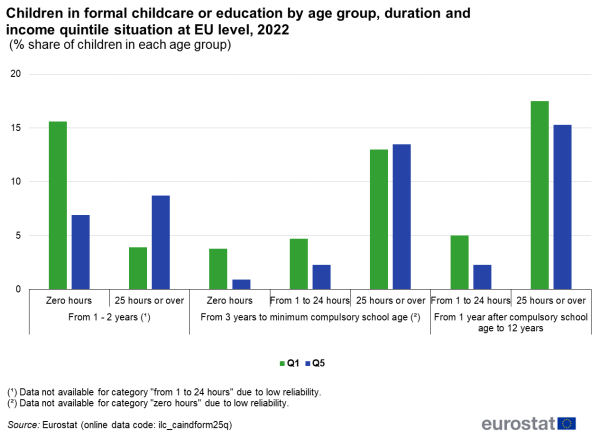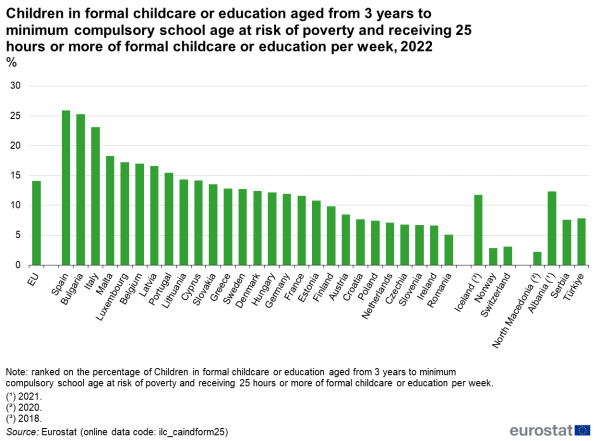Living conditions in Europe - childcare arrangements
Data extracted in January 2024.
Planned update: 27 November 2024.
Highlights
In the EU, the share of children in formal care or education increased with age in 2022.
Among children aged less than 3 in the EU, the share receiving formal childcare or education for 25 hours or more per week increased with income levels.
In 2022, the share of EU children aged from 3 years to the minimum compulsory school age who do not participate in formal childcare or education was twice as high for children at risk of poverty or social exclusion (17.4% compared to 8.8% for those not at risk).
Children in formal childcare or education aged from 3 years to minimum compulsory school age at risk of poverty and receiving 25 hours or more of formal childcare or education per week, 2022
Full article
Key findings
In 2022, the share of children in formal childcare or education in the EU increased with age from less than half (45.8 %) for those aged 1 to 2 years to 89.2 % of those aged from 3 years to the minimum compulsory school age, with participation of nearly all (99.3 %) children aged 1 year after compulsory school age to 12 years.
Children at risk of poverty or social exclusion (AROPE) in the EU had lower rates of receiving formal childcare or education compared to those who were not at risk.
Across all income quintiles, the share of children aged 1 to 2 years not in formal childcare or education was 15.6 % in the first quintile as compared with 6.9 % in the fifth quintile. Similar trends were observed for children aged from 3 years to the minimum compulsory school age.
In 2022, 14.1 % of EU children aged 3 years to the minimum compulsory school age were at risk of poverty or social exclusion and received 25 hours or more of formal childcare or education per week. Spain, Bulgaria, and Italy reported the highest rates.
Childcare arrangements
The share of children in the EU receiving formal childcare increases with age
In the EU, formal childcare or education was received by 45.8 % of children aged 1 to 2 years, while for children aged from 3 years to the minimum compulsory school age, the share was 89.2 %. For all EU children aged 1 year after compulsory school age to 12 years, 99.3 % received formal childcare or education (see Figure 1).
In 2022, 54.2 % of all children in the EU aged 1 to 2 years did not receive any formal childcare. For the same age group, 12.4 % of all EU children participated in formal childcare for 1 to 24 hours per week, whereas 33.4 % received 25 hours or more of formal childcare or education. In the case of children aged from 3 years to the minimum compulsory school age, 70.8 % participated for at least 25 hours per week in formal childcare or education, whereas 18.4 % received formal childcare or education for 1 to 24 hours per week, and 10.8 % did not receive any formal childcare or education. In the age group from 1 year after compulsory school age to 12 years, only 0.7 % of all EU children did not receive any formal childcare or education. A higher share, 17.5 %, participated in formal childcare or education for 1 to 24 hours, while a larger majority, 81.8 %, received at least 25 hours per week.

(%)
Source: Eurostat (ilc_caindform25)
EU children at risk of poverty or social exclusion aged from 3 years to the minimum compulsory school age received less formal childcare or education compared to those not at risk
In 2022, 17.4 % of EU children aged from 3 to the minimum compulsory school age at risk of poverty or social exclusion did not participate in any formal childcare or education, compared with 8.8 % among those not at risk (see Figure 2).

(%)
Source: Eurostat (ilc_caindform25)
Among children aged less than 3, the share receiving formal childcare or education for 25 hours or more per week increased with income levels
In 2022, across all income quintiles, the highest share of children aged 1 to 2 years not receiving formal childcare or education was in the first income quintile (Q1) at 15.6 % to be compared with 6.9 % in the fifth quintile (Q5) (see Figure 3). For children aged from 3 years to the minimum compulsory school age, the percentage not receiving any formal childcare or education decreased from 3.8 % in Q1 to 0.9 % in Q5.

(% share of children in each age group)
Source: Eurostat (ilc_caindform25q)
The share of children aged from 3 years to the minimum compulsory school age receiving 25 hours or more per week varied across countries by AROPE status
In 2022, 14.1 % of EU children aged 3 years to the minimum compulsory school age were at risk of poverty or social exclusion and received 25 hours or more of formal childcare or education per week (see Figure 4). Across EU Member States, the highest shares were recorded in Spain (25.9 %), Bulgaria (25.3 %), and Italy (23.1 %), and the lowest in Romania (5.1 %), Ireland (6.6 %), and Slovenia (6.7 %).

(%)
Source: Eurostat (ilc_caindform25)
Source data for tables and graphs
Data sources
The data used in this article are derived from the European Statistics on income, social inclusion and living conditions (EU-SILC). EU-SILC data are compiled annually and are the main source of statistics that measure income and living conditions in Europe; it is also the main source of information used to link different aspects relating to the quality of life of household and individuals. The reference population for the information presented in this article is all private households and their current members residing in the territory of an EU Member State (or non-member country) at the time of data collection; persons living in collective households were excluded from the target population. The data for the EU are population-weighted averages of national data. The reference period for information on income is 2021, while the other households’ characteristics are referenced to 2022.
Context
Formal childcare is intended as a formal education programme that is institutionalized, intentional and planned through public organizations and recognized private bodies, in line with the formal education definition of ISCED 2011 classification. Other types of childcare might encompass care that is provided by a professional child-minder at the child’s home or at the child-minders’ home, as well as care provided by grandparents, other household members (outside parents), other relatives, friends or neighbours.
Following the Council Recommendation of 8 December 2022 on early childhood education and care: the Barcelona Targets for 2030 (2022/C 484/01), Eurostat defined in 2023 a new indicator for measuring ‘Children in formal childcare or education by age group and duration’, setting the threshold for the number of hours in formal childcare or education at 25 hours per week, and breaking the indicator down by the at risk of poverty or social exclusion (AROPE) status (ilc_caindform25) and by income quintile (ilc_caindform25q). In addition, together with the three age groups already available in the former indicator (ilc_caindformal), an additional age group has been added for children aged 1 or 2 years old. Furthermore, the variances and confidence intervals for each particular breakdown are available in a dedicated CIRCBC folder.
Direct access to
- European Commission — Directorate General for Employment, Social Affairs & Inclusion: Indicators' Sub-Group of the Social Protection Committee
- European Commission — Directorate General for Employment, Social Affairs & Inclusion: European employment strategy
- European Commission — Directorate General for Employment, Social Affairs & Inclusion: Employment and social analysis
- European Commission — Directorate-General for Employment, Social Affairs and Inclusion — Work-life balance initiatives